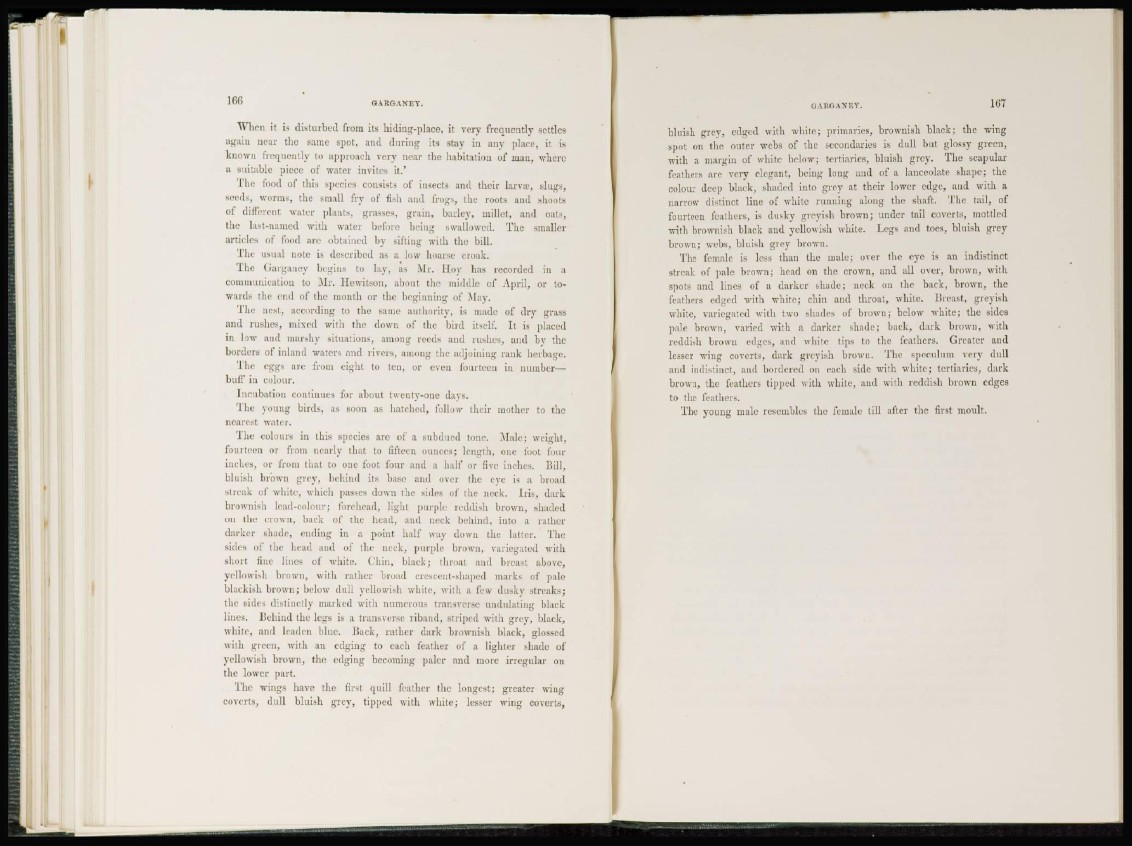
When it is disturbed from its Hiding-place, it very frequently settles
again near the same spot, and during its stay in any place, it is
known frequently to approach very near the habitation of man, where
a suitable piece of water invites i t .'
The food of this species consists of insects and their larva1 , slugs,
seeds, worms, the small fry of fish and frogs, the roots and shoots
of different water plants, grasses, grain, barley, millet, and oats,
the last-named with water before being swallowed. The smaller
articles of food are obtained by sifting with the bill.
The usual note is described as a low hoarse croak.
The (iargatiey begins to lay, as Mr. Hoy has recorded in a
communication to Mr. Hewitson, about the middle of April, or towards
the end of the month or the beginning of May.
The nest, according to the same authority, is made of dry grass
and rushes, mixed with the down of the bird itself. It is placed
in low and marshy situations, among reeds and rushes, and by the
borders of inland waters and rivers, among the adjoining rank herbage.
'1 he eggs arc from eight to ten, or even four teen in number—
buff in colour.
Incubation continues for about twenty-one days.
The young birds, as soon as hatched, follow their mother to the
nearest water.
The colours in this species are of a subdued tone. Male; weight,
fourteen or from nearly that to fifteen ouuecs; length, one foot four
inches, or from that to one toot four and a half or five inches. Bill,
bluish brown grey, behind its base and over the eye is a broad
streak of white, which passes down the sides of the neck. Iris, dark
brownish lead-colour; forehead, light purple reddish brown, shaded
on I he crown, back of the head, and neck behind, into a rather
darker shade, ending in a point half way down the latter. The
sides of the head and of the neck, purple brown, variegated with
short fine lines of white, ('bin, black; throat and breast above,
yellowish brown, with rather broad crc»cent-shaped marks of pale
blackish brown; below dull yellowish while, with a few dusky streaks;
the sides distinctly marked with numerous transverse undulating black
lines. Behind the legs is a transverse riband, striped with grey, black,
white, and leaden blue. Back, rather dark brownish black, glossed
with green, with an edging to each feather of a lighter shade of
yellowish brown, tin; edging becoming paler and more irregular on
the lower part.
The wings have the first quill feather the longest; greater wing
coverts, dull bluish grey, tipped with white; lesser wing coverts,
bluish grey, edged with white; primaries, brownish black; the wing
spot on the outer webs of the secondaries is dull but glossy green,
with a margin of white below; tertiaries, bluish grey. The scapular
feathers are very elegant, being long and of a lanceolate shape; the
colour deep black, shaded into grey at their lower edge, and with a
narrow distinct line of white running along the shaft. The tail, of
fourteen feathers, is dusky greyish brown; under tail coverts, mottled
with brownish black and yellowish white. Tegs and toes, bluish grey
brown; webs, bluish grev brown.
The female is less than the male; over the eye is an indistinct
streak of pale brown; head on the crown, and all over, brown, with
spots and lines of a darker shade; neck on the back, brown, the
feathers edged with white; chin and throat, white. Breast, greyish
white, variegated with two shades of brown; below white; the sides
pale brown, varied with a darker shade; back, dark brown, with
reddish brown edges, and white tips to the feathers. Greater and
lesser wing coverts, dark greyish brown. The speculum very dull
and indistinct, and bordered on each side with white; tertiaries, dark
brown, the feathers tipped with white, and with reddish brown edges
to the feathers.
The young male resembles the female till after the first moult.